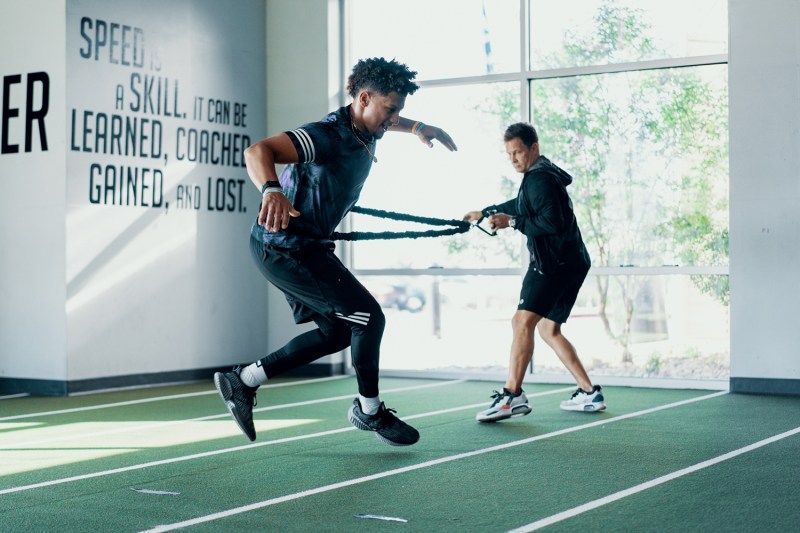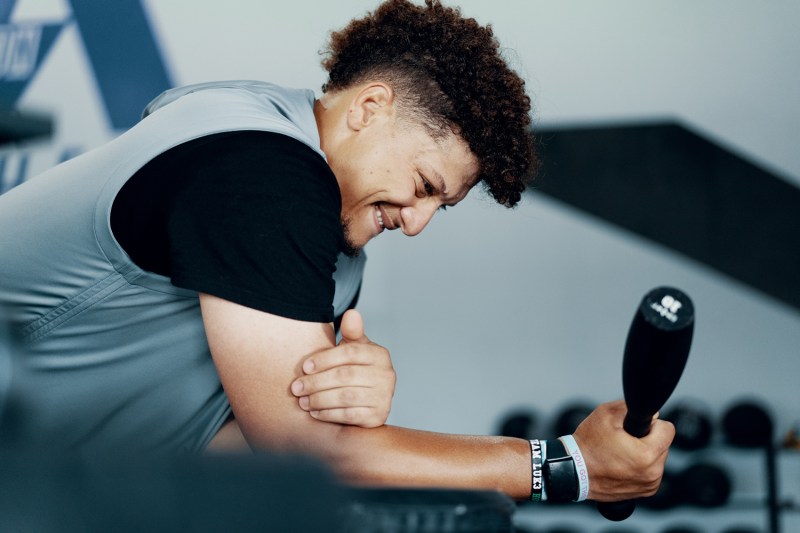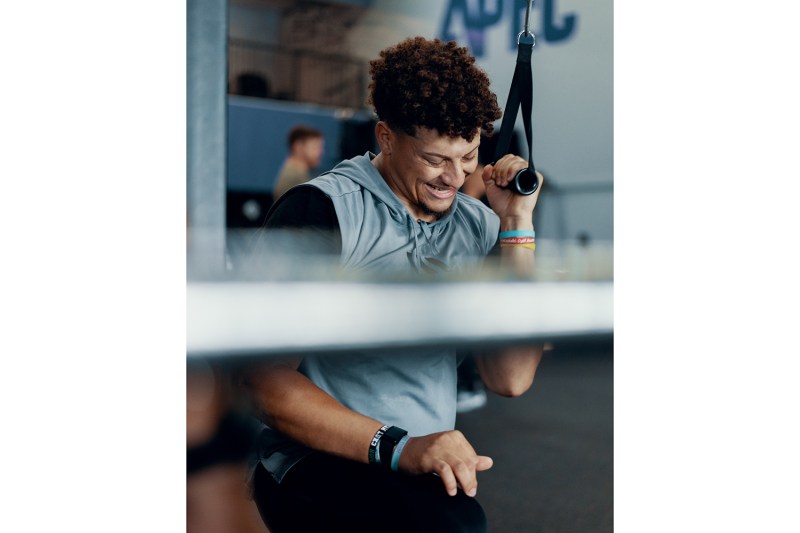
Behind a brilliant player like the Kansas City Chiefs’ Patrick Mahomes is a brilliant trainer. That man is Bobby Stroupe, a 41-year-old lifelong Texan who met the future football great when he was in fourth grade. Back then, everything was done by group, and Mahomes was just one of many kids who, in small pods, may not have recognized their own future greatness but were united by the desire to get better. And that’s what the future Super Bowl Champ and NFL MVP would do, one day at a time. “I know from the outside a lot of people feel like he’s this gifted person,” Stroupe says. “And while that’s obvious, he’s one of the hardest working human beings that I’ve ever been around.”
Stroupe knows a bit about hard work himself: Once the smallest kid in his class, boy or girl, through the eighth grade and with Forrest Gump-style braces on his legs, he worked through his growth spurt to set high school records in track and field, powerlifting, and football. It was in the latter that he would focus, playing in college and later on an arena team, though even then, he says, the sport wasn’t his ultimate goal. “From a pretty young age, I knew exactly what I wanted to do,” he says, “and what I wanted to do was help kids who were like myself.”
Related Guides
Helping pro athletes achieve peak physical condition was never the goal — Stroupe has been training athletes of all levels since he was in high school himself, and his company, APEC, has worked with individuals from kindergarten through the pro ranks since 2005. But with his metric-focused philosophy, the pros have come in a similar manner as Mahomes: an outgrowth of the everyday. While he continues to train the football star, to date, he’s worked with more than 200 pro athletes competing across six sports.
Granted, some concepts have remained the same since he was a prep athlete. Weight, after all, is still weight, and those dumbbells aren’t going to lift themselves. But the greatest difference between then and now, he says, is in our understanding of the central nervous system and its optimization. “It would be the equivalent of if your batteries are running out in your favorite toy when you’re a kid. You start to see little holes in performance and then all of a sudden you can’t play with your friends because your toy’s deficient until you get new batteries. Well, we’re no different.”
Stroupe, in partnership with Whoop
Strength Isn’t Everything

Stroupe says that you can be built like a brick shithouse, but if your body is run down or you’re unable to recover between workouts, it won’t matter. “The driver is the electrical component, and if the electrical component is right, then the conditioning of your tissues is really secondary and maybe even further down the list.” Really, the question shouldn’t be on your capability at your peak but on the level of fatigue right now. The easiest way to discover this, of course, is through fitness trackers by Whoop and others, which monitor things like resting heart rate over time. Its elevation can indicate an increased level of fatigue and lack of recovery since your last hard effort.
Conditioning Versus Technique
Some athletes, including runners and cyclists, are focused primarily on conditioning, with a secondhand focus on technique. Others, in ball sports like tennis, basketball, and Mahomes’ football, must contend with equal parts conditioning, technique, and tactical development. Stroupe admits the number of elements that a football quarterback must incorporate can be overwhelming. But the reality, he says, is that if recovery between conditioning is emphasized, those other areas can only benefit. “[Athletes’] reaction capabilities and their mental processes are going to be sharper, so they’re going to make better decisions,” he explains.
Sleep It Off
Stroupe points to a famous Stanford University study, published in 2011, in which its basketball team, deprived of sleep, saw its turnovers jump 28%. Sleep was then increased to a minimum of 10 hours a night, and would you guess, turnovers shrank 40%, while sprint times dropped and three-point accuracy improved almost by double digits, among other beneficial effects. “When you’re a quarterback, it could mean the difference between seeing something that breaks the game open and making a game-breaking mistake,” he says. So if you’re looking to increase your recovery and right a banged-up ship, the easiest way is to turn in early and often. Your performance can only improve.
Read more: How to Sleep Better
Responding to Wacky Stats

Hey, sometimes you’re just run down, and your fitness wearable is letting you know. According to Stroupe, that’s not always a bad thing. “We’re looking for adaptations,” he says. “We need to impose different types of exposures to get these adaptations. If you don’t get the recovery scores low at some point, why would the body change?” Of course, how long your body stays in that zone is what’s important, and after a dip, you should be focusing on bringing it back to normal levels. “If [you’re] in those places 10 days running, you’ve done something wrong.”
Performing Through Fatigue
And on the subject of low recovery scores or elevated levels of body fatigue and distress: That doesn’t necessarily mean you’re destined for a bad session at the gym. “I’ve seen Patrick have incredible workouts and incredible game performances with sub-optimal recovery scores,” he says. The key is not the recovery score but in the nature of the man: “He is a performer and understands to draw what is available to him to do what is necessary to get done.” Maybe that’s you in YMCA basketball pickup game or alone running laps on a track, but one score doesn’t necessarily mean the end. Stay engaged and see what you’ve got — you may surprise yourself.
Don’t Panic
Let’s say you wake up the morning of an important workout, game, or race, only to find that your metrics indicate you’re still carrying baggage from your last hard effort. Do you pull the plug? Punt to next week? Call in sick? Stroupe suggests that if there’s time between now and that maximal effort, what happens between now and then is critical. Take a nap. Get a massage. Drink water and eat well. All of these things can help improve your score in the interim. “It’s unreasonable to think that every single game day you’re going to hit 95% recovered because there are a lot of factors at play,” he says. “The guys that are the best, they’re not accepting of those narratives in their head, and psychologically, when you’re in that space, your body is going to follow.”
Data-Obsessed

Stroupe admits he prefers working with athletes who have the resilience to compete rather than feel enslaved to data. And who wouldn’t? But just like you, some of the men and women that darken his door can get a little obsessed with incorporating the biometric equivalent of Moneyball. “The athletes that are overly obsessed, I don’t know that it’s always healthy,” he says. The solution is simple: Take a break. That’s not to say that you have to throw your watch in the junk drawer for the next few weeks — by all means, keep wearing it. But stop checking in. If you’ve got a coach, feel free to provide access (Stroupe himself continues to monitor and adjust workouts accordingly), but you yourself shouldn’t peek.
The X-Factor
Michael Jordan’s “Flu Game,” when he sliced through a hapless Utah Jazz in game five of the 1997 NBA Finals despite seeming on the verge of collapse between plays due to illness, is just one of numerous examples in sports where the athlete transcends the situation. Stroupe himself admits that troubling metrics pre-game don’t necessarily dictate the performance. “When the body is against the wall, and you send a message back to the body that there is something that has to be done, the best of the best, they’re going to produce an abnormal amount of neurotrophic growth factor, different adrenal factors, that are going to be a cocktail to get them over the hump.” Of course, with every transcendent performance, there’s a cost, and doubly so for the ones that come when you’re already in a hole. “When the game is over, they’re worthless,” he says. The goal with these is to adjust training in the following days, taking even greater caution while nursing yourself back to health.
When in Doubt, Call a Coach
Mahomes and Stroupe have worked together for decades, forging trust over time. Granted, you may not have a similar relationship in your life, but if you’re currently employing a coach, when all else fails, trust. “The coach-athlete relationship boils down to communication, trust, honesty, and the ability to audit yourself and feel comfortable in your space doing that,” Stroupe says. If you don’t feel that with your current trainer, either commit or search for someone with whom you can.



